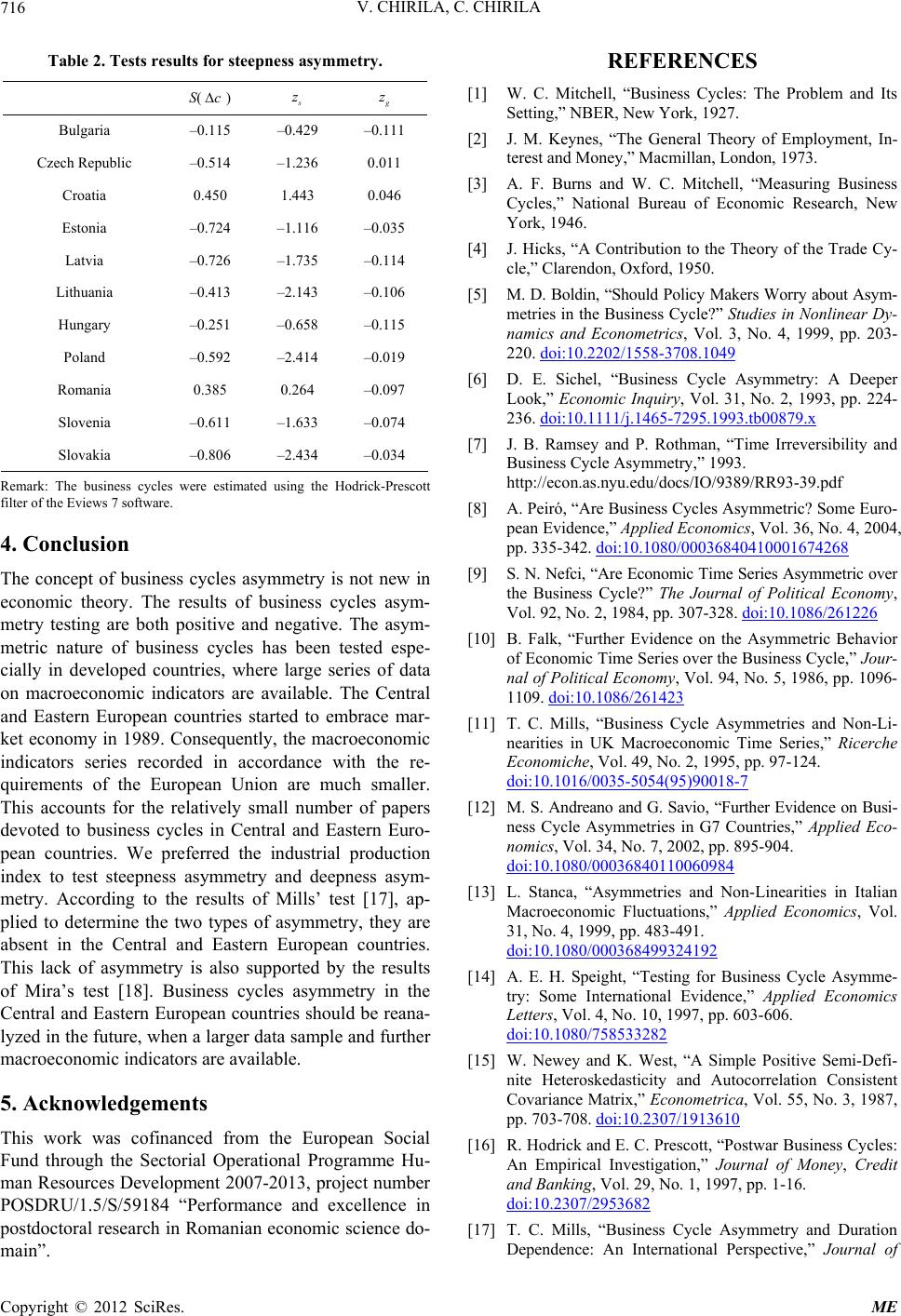
V. CHIRILA, C. CHIRILA
716
Table 2. Tests results for steepness asymmetry.
S() c
z
z
Bulgaria –0.115 –0.429 –0.111
Czech Republic –0.514 –1.236 0.011
Croatia 0.450 1.443 0.046
Estonia –0.724 –1.116 –0.035
Latvia –0.726 –1.735 –0.114
Lithuania –0.413 –2.143 –0.106
Hungary –0.251 –0.658 –0.115
Poland –0.592 –2.414 –0.019
Romania 0.385 0.264 –0.097
Slovenia –0.611 –1.633 –0.074
Slovakia –0.806 –2.434 –0.034
Remark: The business cycles were estimated using the Hodrick-Prescott
filter of the Eviews 7 software.
4. Conclusion
The concept of business cycles asymmetry is not new in
economic theory. The results of business cycles asym-
metry testing are both positive and negative. The asym-
metric nature of business cycles has been tested espe-
cially in developed countries, where large series of data
on macroeconomic indicators are available. The Central
and Eastern European countries started to embrace mar-
ket economy in 1989. Consequently, the macroeconomic
indicators series recorded in accordance with the re-
quirements of the European Union are much smaller.
This accounts for the relatively small number of papers
devoted to business cycles in Central and Eastern Euro-
pean countries. We preferred the industrial production
index to test steepness asymmetry and deepness asym-
metry. According to the results of Mills’ test [17], ap-
plied to determine the two types of asymmetry, they are
absent in the Central and Eastern European countries.
This lack of asymmetry is also supported by the results
of Mira’s test [18]. Business cycles asymmetry in the
Central and Eastern European countries should be reana-
lyzed in the future, when a larger data sample and further
macroeconomic indicators are available.
5. Acknowledgements
This work was cofinanced from the European Social
Fund through the Sectorial Operational Programme Hu-
man Resources Development 2007-2013, project number
POSDRU/1.5/S/59184 “Performance and excellence in
postdoctoral research in Romanian economic science do-
main”.
REFERENCES
[1] W. C. Mitchell, “Business Cycles: The Problem and Its
Setting,” NBER, New York, 1927.
[2] J. M. Keynes, “The General Theory of Employment, In-
terest and Money,” Macmillan, London, 1973.
[3] A. F. Burns and W. C. Mitchell, “Measuring Business
Cycles,” National Bureau of Economic Research, New
York, 1946.
[4] J. Hicks, “A Contribution to the Theory of the Trade Cy-
cle,” Clarendon, Oxford, 1950.
[5] M. D. Boldin, “Should Policy Makers Worry about Asym-
metries in the Business Cycle?” Studies in Nonlinear Dy-
namics and Econometrics, Vol. 3, No. 4, 1999, pp. 203-
220. doi:10.2202/1558-3708.1049
[6] D. E. Sichel, “Business Cycle Asymmetry: A Deeper
Look,” Economic Inquiry, Vol. 31, No. 2, 1993, pp. 224-
236. doi:10.1111/j.1465-7295.1993.tb00879.x
[7] J. B. Ramsey and P. Rothman, “Time Irreversibility and
Business Cycle Asymmetry,” 1993.
http://econ.as.nyu.edu/docs/IO/9389/RR93-39.pdf
[8] A. Peiró, “Are Business Cycles Asymmetric? Some Euro-
pean Evidence,” Applied Economics, Vol. 36, No. 4, 2004,
pp. 335-342. doi:10.1080/00036840410001674268
[9] S. N. Nefci, “Are Economic Time Series Asymmetric over
the Business Cycle?” The Journal of Political Economy,
Vol. 92, No. 2, 1984, pp. 307-328. doi:10.1086/261226
[10] B. Falk, “Further Evidence on the Asymmetric Behavior
of Economic Time Series over the Business Cycle,” Jour-
nal of Political Economy, Vol. 94, No. 5, 1986, pp. 1096-
1109. doi:10.1086/261423
[11] T. C. Mills, “Business Cycle Asymmetries and Non-Li-
nearities in UK Macroeconomic Time Series,” Ricerche
Economiche, Vol. 49, No. 2, 1995, pp. 97-124.
doi:10.1016/0035-5054(95)90018-7
[12] M. S. Andreano and G. Savio, “Further Evidence on Busi-
ness Cycle Asymmetries in G7 Countries,” Applied Eco-
nomics, Vol. 34, No. 7, 2002, pp. 895-904.
doi:10.1080/00036840110060984
[13] L. Stanca, “Asymmetries and Non-Linearities in Italian
Macroeconomic Fluctuations,” Applied Economics, Vol.
31, No. 4, 1999, pp. 483-491.
doi:10.1080/000368499324192
[14] A. E. H. Speight, “Testing for Business Cycle Asymme-
try: Some International Evidence,” Applied Economics
Letters, Vol. 4, No. 10, 1997, pp. 603-606.
doi:10.1080/758533282
[15] W. Newey and K. West, “A Simple Positive Semi-Defi-
nite Heteroskedasticity and Autocorrelation Consistent
Covariance Matrix,” Econometrica, Vol. 55, No. 3, 1987,
pp. 703-708. doi:10.2307/1913610
[16] R. Hodrick and E. C. Prescott, “Postwar Business Cycles:
An Empirical Investigation,” Journal of Money, Credit
and Banking, Vol. 29, No. 1, 1997, pp. 1-16.
doi:10.2307/2953682
[17] T. C. Mills, “Business Cycle Asymmetry and Duration
Dependence: An International Perspective,” Journal of
Copyright © 2012 SciRes. ME